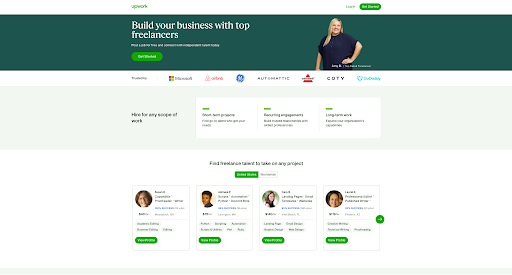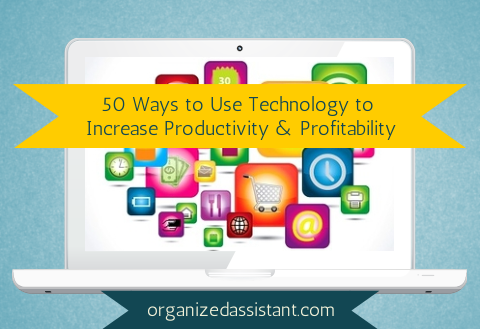Productivity Trends of 2021 and Beyond
This page may contain links to Amazon.com or other sites from which I may receive commission on purchases you make after clicking on such links. Read my full Disclosure Policy

The world is constantly evolving, with factors such as new technologies and the COVID-19 pandemic introducing new changes and hurdles to productivity and increasing the need to be more organized. As my guest today, Lindsey Smith shares insight into the latest productivity trends so you can best prepare to serve your clients.

No matter the industry, everyone wants to increase productivity, improve their team’s effectiveness, and boost profits. But while everything we know about business and productivity is changing rapidly, how can you help companies optimize their workflows?
The global pandemic is the key accelerator for much of this change, but some of these trends have been emerging for a long time. However, today things are evolving faster than some businesses can keep up with.
For businesses to meet the challenges of the new world and achieve their productivity goals, they have to keep adapting. Let’s look at some of the current productivity trends that not only affect the way employees work (and feel) but also have a significant impact on profits and losses.
1. Remote Work Is Here to Stay
The pandemic has led to a lot of people working from home for the first time, and many have discovered it to be a positive alternative to a traditional office. The ability to work from anywhere, avoid the commute, reduce stress, and be free from a dress code sounds like a dream, right?
That’s the new normal for many workers, and as the trend persists, it’s clear that remote work isn’t going anywhere.
Some businesses have embraced a hybrid workforce, where some employees are in the office while others are remote for some or all of the workweek. But for all employees who have at least partially traded their cubicle for a home office, there’s a need to adjust to new digital forms of communication.
A remote or hybrid workforce needs to effectively work together on projects. And their employers need new ways to track productivity and collect data such as computer usage and effectiveness. They need ways to assess the performance of their employees and create a positive work environment in the virtual world.
For these teams, digital communication platforms are essential. Usage of camera-focused apps like Zoom, Google Meet, and Skype has surged as a result of remote work. And agile project management platforms like Monday.com, PickUp, and Trello, are popular tools for productivity and collaboration.
2. Freelance Work Is Creating Opportunities for Companies and Workers

Image Source: Upwork
The flexibility offered by gig or freelance workers compared to full-time employees not only allows companies to save money on payroll and benefits, but their diverse skill sets can also create new business opportunities.
Platforms like Fiverr and Upwork are popular tools for freelancers to find gigs as many in the workforce are stepping into freelancing.
Some companies cut their freelance budget when the pandemic began, but many have embraced gig workers to supplement employee shortages, fill gaps in staff for temporary projects, and bring specific skill sets to the team that might not be needed on a permanent basis.
With the global changes happening in business, contract workers give companies the freedom to experiment with new approaches in their operations and bring in new perspectives—while the permanent workforce might be less willing to try new things and lose their motivation over time.
3. Automation Is the Future

Photo by Possessed Photography on Unsplash
You always want to help companies work smarter instead of harder. Companies are investing in technology that will save time and effort, automate processes, and free employees from mundane tasks so they can develop competencies, like SEO skills, that will enhance their careers and the companies they work for.
No matter how big or small a company is, artificial intelligence (AI) can likely enhance, change, or replace business operations and boost their productivity to the next level.
Our cars still can’t fly, but AI technology that would have seemed like sci-fi a few years ago is creating massive advancements in productivity.
Not only can this technology improve business models, but it can also lead companies in new directions and change the model completely—all for the better.
4. Where Did the Day Go? Time Tracking Is Answering That Question
Image Source: Clockify
With so many workers going remote, some employers have felt the need to monitor and manage staff time more than ever. Workers may have traded boardrooms for video calls, but how much work is actually getting done in those PJs?
Time tracking platforms like Clockify and Toggl are popular among remote teams, but this software isn’t only about generating timesheets, but it’s also a smart tool that can make significant changes in work processes and how employees spend and organize their workday.
The data generated by such software gives insight into time spent on each task, when each employee is most productive, and how to price and bill projects. Employers can leverage this data to maximize efficiency, productivity, and profitability.
Consequently, doing less work can maximize their efforts. By minimizing tasks and re-evaluating time-consuming and unproductive work, businesses can get more out of their employees’ workday.
“This meeting could have been an email” is a workplace cliché, but if you can help employers discover which meetings truly could have been emails, they can improve time management for everyone. Effective communication saves time and energy for the tasks that really need them.
5. Everyone Wants a Healthy Work-Life Balance
Regardless of the software a company has adopted to grow their organization, it is the people that make or break a business. With the pandemic changing everything around us and creating stress and uncertainty for many, it’s important for employees and employers to be cognizant of their physical and mental well-being.
Workers are opting for non-financial benefits such as adjusted work time, health care, and child care, and the ability to unplug during off-hours. Remote work could be a detriment to mental health as employers spend less time face-to-face with their team and therefore may fail to understand team members and their specific needs and behavior.
Employee turnover is expensive, and recruiting and training new hires can damage productivity and the overall effectiveness of a team. While many professionals are always ready to take a better job if the opportunity comes along, employers can reduce turnover and mitigate lost productivity by promoting a healthy work-life balance among their team.
To prevent burnout and poor company culture, employers are paying close attention to the engagement levels in their workforce and helping them stay connected to their coworkers—and making sure they know there are healthcare options if they need them. And they are promoting company culture and spaces for collaboration, whether face-to-face or separated by thousands of miles.
Embrace Change and Help It Work in Their Favor
Not every trend fits everyone, and not every change needs to happen fast. However, working toward a better company culture where employees feel appreciated and comfortable, implementing artificial intelligence, optimizing processes, and managing time wisely will help teams work better together and improve productivity.













I am wondering if remote work is improving work/life balance. I hope so. As far as remote work. I live in the Washington DC area and watch what the federal government is doing as the way things are going to do. The government has been quite strict about sending people back to work and I think most businesses around here are following their lead. There is going to be a lot of empty office space in this area very soon.
That seems to be the case here too. I met a friend downtown for lunch a few weeks ago, and it was strange not to see any government or other office workers in the restaurant or the mall that it’s in.
Watching young adults that I know has made clear to me that hybrid and remote work is here to stay. They really want flexibility, and few want to move back to the city and go into work every day.
I think it has benefits, but it also does make the work life balance a bit trickier. You can’t leave work behind at the office because it is right there with you.
Gotta embrace these trends and make them work for you, right?
My friend’s daughter had been working from home since the start of the pandemic when her employer told her she had return to the office on a certain date. Fortunately for her but not her employer, she landed and started another job where she is allowed to work from home before that date came around.
Working from home is clearly here to stay and that will affect how we manage our time. I think we all need to consider a new work/life balanace.
Career Professionals of Canada developed a Work-Life Coaching Certificate Course because this has become such an important skill for anyone helping clients with living, learning or working. At least one POC member has completed it and become a Certified Work-Life Strategist.
Seconding the Trello recommendation! I use it every day for business and personal things. It helps keep me on track, and I can share tasks with my team members easily.
Great article!
I’ve tried it but it doesn’t seem to work the way my brain does. I keep going back to it though, because it has so much potential!